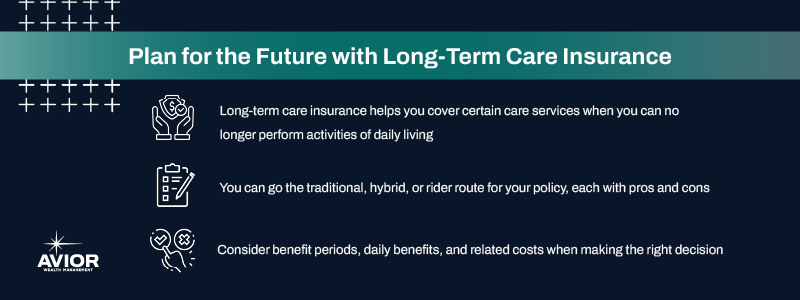Plan for the Future with Long-Term Care Insurance
Find out what kind of policy options you have for long-term care insurance and how to strike the right balance with your investment

It’s easy to put off long-term care insurance planning. However, failing to plan now with insurance may mean you’ll be unprepared for the financial and emotional challenges that come when you or a family member needs long-term care.
An estimated 7.7 million Americans need long-term care services and support, including within an institutional setting, yet most people say they don’t feel prepared to deal with these care costs.
This type of coverage can be complex to navigate, but thinking about these concerns now can help you establish a solid foundation for peace of mind and familial support later in life. This guide covers how long-term care insurance works, types of policies, and key considerations when making your coverage choices.
What is long-term care insurance?
Long-term care insurance is a specialized form of coverage. It aims to help you and your family members manage the financial costs associated with extended periods of care needed due to chronic illnesses, disabilities, or cognitive impairments. Covered expenses related to long-term care services include nursing home care, assisted living facilities, in-home care, and other support services.
For long-term care coverage to begin, the policyholder must be experiencing problems with the activities of daily living (ADLs), which include bathing, getting dressed, eating, transferring, continence, and toileting. Usually, you must be unable to do at least two of these six ADLs to receive your insurance benefits.
The costs associated with this type of intensive care can be substantial and may erode a significant portion of your retirement savings. Insurance provides a financial safety net by helping to cover these expenses, ensuring you can access the care you need without depleting other assets or burdening your family with the full financial responsibility.
In addition, long-term care insurance gives you the flexibility to receive care in settings that align with your preferences. This kind of flexibility can enhance the quality of life for retirees.
Types of long-term care insurance policies
As with any type of insurance, there are a few different types of long-term care coverage to research. Here is a quick overview of the options:
- Traditional policies: This is the standard long-term care insurance policy, and your premiums are variable and can be expensive. Note that everything you’ve paid in premiums will be lost if you cancel this policy.
- Hybrid policies: Some people decide to pair life insurance with long-term care coverage. Your one premium could cover both benefits and anything you pay in premiums, you can get back after you fully pay the premium. In this case, if you never use this coverage, your beneficiaries will receive the premiums paid. You also get the death benefit, free of taxes, from your life insurance policy.
- Life insurance with riders: You can also add a rider to your current life insurance policy. With these riders, you can borrow death benefits to help you pay for long-term care expenses. This can be a good option, but remember that it will reduce the death benefit your beneficiaries will receive.
The type of policy you choose will depend on factors like your income, other investments and savings, health status, and long-term goals. Talking your options over with a financial professional can help you match your priorities with coverage.
Coverage terms and benefits to consider
So, how do you select the right coverages? Thoroughly assess several key areas to align your policy with your specific needs and financial situation:
Benefit periods
First, the benefit period is fundamental, representing the duration that the policy will pay for covered services. Longer benefit periods provide extended coverage but may come with higher premiums. Balance your anticipated needs with the financial feasibility of the coverage duration.
The elimination period, also known as the waiting period, refers to the time between when you become eligible for benefits and when the policy actually starts paying. Choosing a longer elimination period can lower premiums, but it requires careful consideration of your ability to cover potential expenses during that waiting period. Assess your financial stability and risk tolerance to select the elimination period that strikes the right balance.
Daily benefits for services
Daily benefit amounts represent the maximum sum the policy will pay for covered services each day. Consider your potential long-term care costs and choose a daily benefit amount that adequately covers those expenses. Consider factors such as inflation and the rising costs of healthcare.
Policies may also restrict pre-existing conditions, provide specific types of care, or limit benefit payments. Review everything carefully to be aware of any potential gaps in coverage.
Cost considerations for long-term care insurance
Several factors influence the cost of long-term care insurance. Age is a primary element, with premiums typically lower when purchasing coverage when you’re younger. Younger people are often perceived as having a lower risk of needing long-term care in the near future. As age increases, the likelihood of requiring care rises, leading to higher premiums.
Health status is another critical cost factor. Individuals in better health may qualify for lower premiums, while those with pre-existing health conditions or a history of certain illnesses may face higher costs or even be denied coverage. Insurers assess health through medical underwriting, considering factors such as chronic conditions, medications, and overall health history.
Policies with higher daily benefit amounts, longer benefit periods, and shorter elimination periods generally have higher premiums. Striking a balance between coverage needs and affordability is essential. Carefully evaluate your financial situation and risk tolerance to optimize your combination of benefits.
Working with a financial expert for insurance planning
A successful approach to long-term care insurance means understanding your options and making selections based on your needs and budget. If you’re not sure which type of policy you need or how much you can afford, talk to a financial advisor at Avior Wealth Management.
Our team of experts ensures you are making well-informed decisions about your and your family’s future. We customize our insurance planning services to your unique situation. Contact us today to get started with Avior.
Disclaimer: Nothing contained herein should be construed as legal or tax advice. Avior and our Advisors will work with your attorney and/or tax professional to assist with your legal and tax strategies. Please consult your attorney or tax professional with specific legal and/or tax questions. Investment Management and Financial Planner are offered through Avior Wealth Management, LLC, an SEC-registered investment advisor. Past performance is not a guarantee of future results. Investments are subject to loss, including the loss of principal.
No Comments
Sorry, the comment form is closed at this time.




